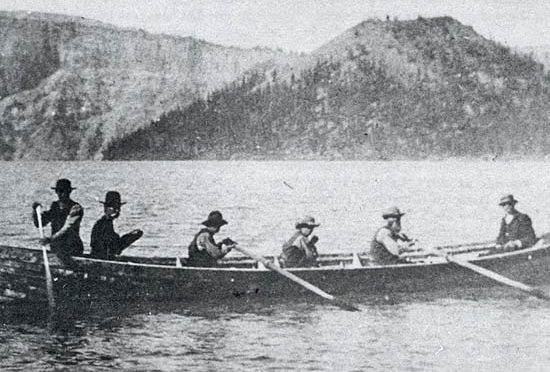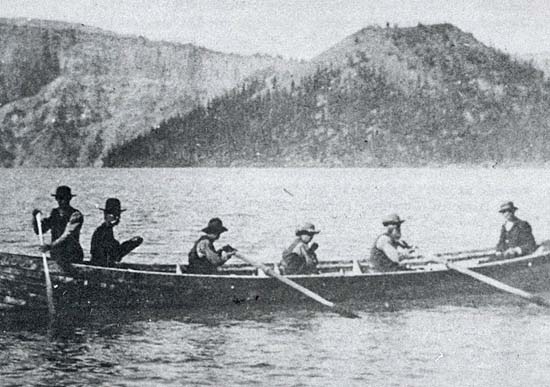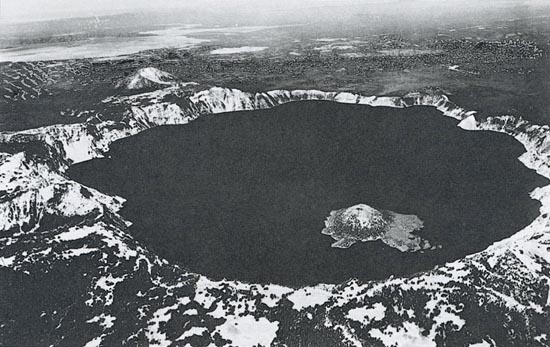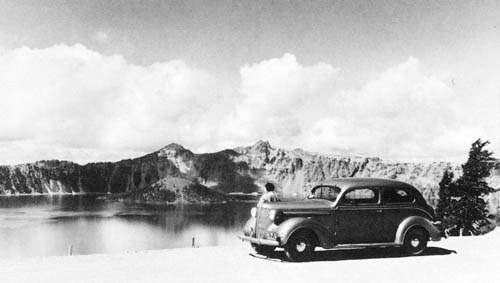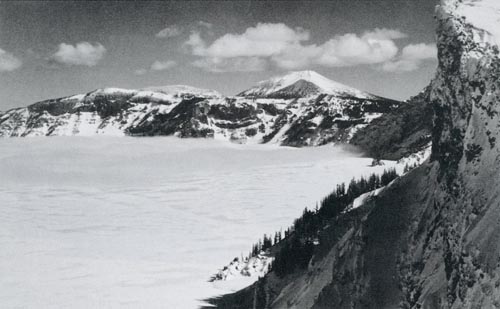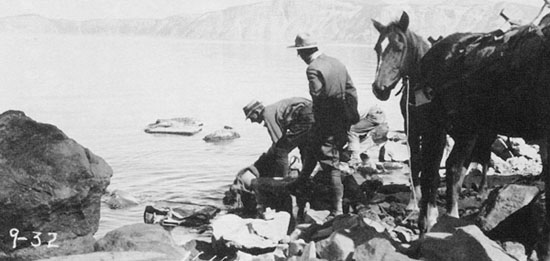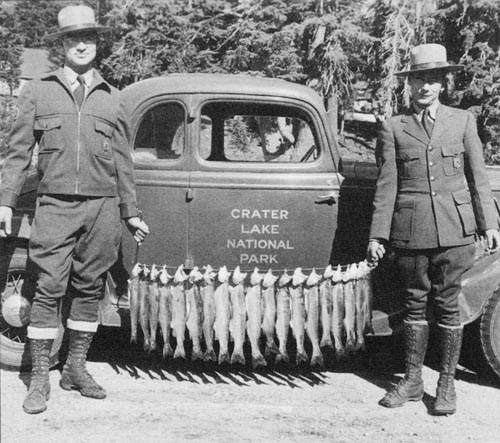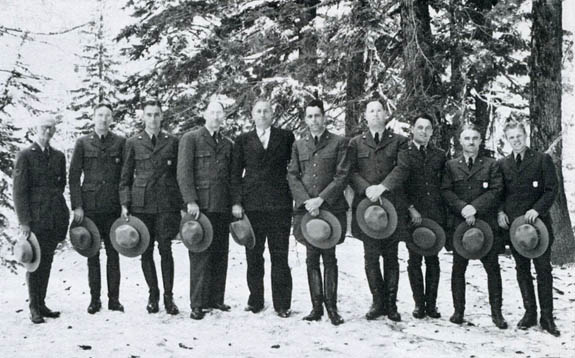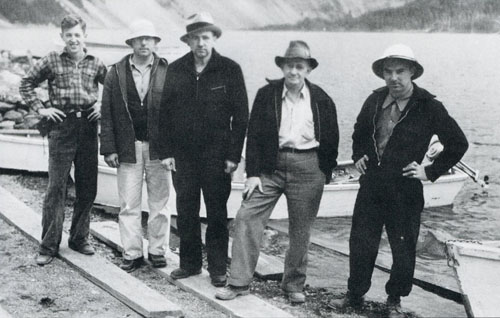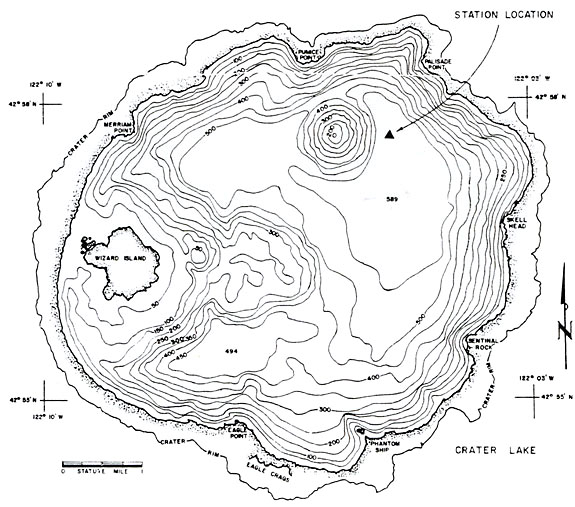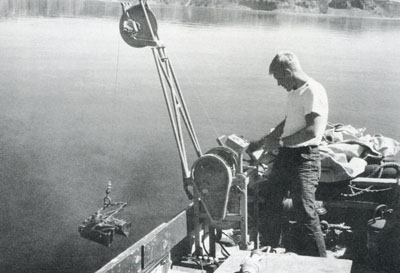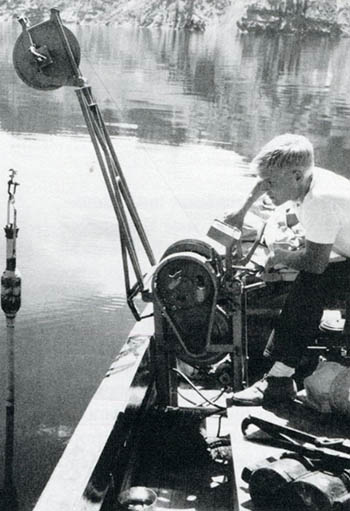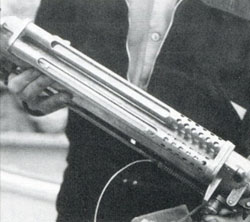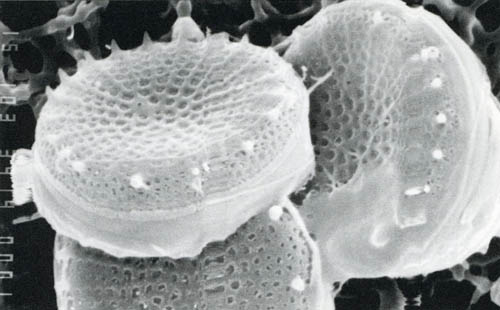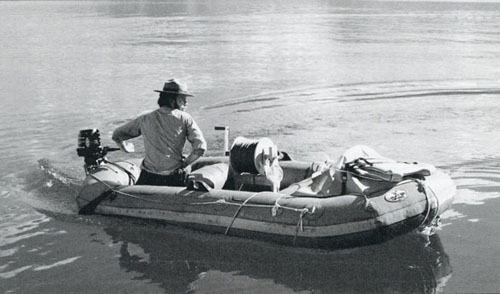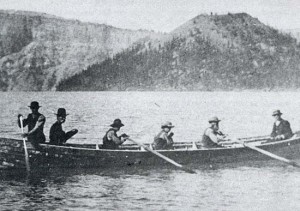
Depths cover
Probing the Depths of Crater Lake: A Century of Scientific Research by Douglas Larson
Crater Lake Institute online library
Over the past one hundred years, more than 25 million people have visited Oregon’s Crater Lake National Park to behold the majestic beauty of what is perhaps the most remarkable lake on Earth. At nearly two thousand feet deep, Crater Lake is the deepest lake in the United States and the seventh deepest in the world. To view the lake, visitors must first journey up the slopes of an ancient volcano, traversing vast pumice fields and scattered mountain meadows, before climbing steep, forested slopes that rise abruptly to the jagged rim of the caldera hundreds of feet above the lake’s surface. Their first breathtaking glimpse of the lake is of an enormous volcanic depression, or caldera, filled with incredibly clear, blue water. “As the visitor reaches the brink of the cliff,” geologist Clarence Dutton promised in his 1886 essay on Crater Lake published in Science, “he suddenly sees below him an expanse of ultramarine blue of a richness and intensity which he has probably never seen before, and will not likely see again. Lake Tahoe may rival this color, but cannot surpass it. . . . It is difficult to compare this scene with any other in the world, for there is none that sufficiently resembles it.” (1) see notes below at bottom of page.
| Early scientists sound Crater lake aboard the Cleetwood in July 1886. |
One of the earliest visitors to Crater Lake was William Gladstone Steel, a Portland businessman and founder of the Mazamas, a local mountain-climbing club. In August 1885, Steel and a colleague stood speechless as they gazed across the lake for the first time. “It all belongs to the government,” Steel exclaimed, “and it’s up to you and me to save this lake!” A few days later, Steel joined Clarence Dutton in a small canvas boat to explore the lake’s shoreline and Wizard Island, an 800-foot-tall cinder cone about one quarter mile offshore. Together, they vowed to protect the lake from lumbermen, sheep ranchers, and land speculators who threatened to exploit the area’s natural resources. (2)
Steel spent the next seventeen years lobbying Congress for legislation to protect and preserve the lake that Dutton had praised as “a little sheet of water which is destined to take high rank among the wonders of the world.” (3) In 1890, Steel wrote and published a book about Crater Lake, The Mountains of Oregon, which was mailed to President Benjamin Harrison, the president’s cabinet, and members of Congress. Steel’s persistence earned him the undeserved title of crackpot and pest. (4) Nevertheless, Congress passed a bill in 1902 designating Crater Lake as a national park. On May 22, 1902, President Theodore Roosevelt signed the legislation, assuring the nation that the lake’s beauty and uniqueness would be protected for “present and future generations.” (5)
| This early aerial view of Crater Lake gives a good view of the caldera and Wizard Island, along with the surrounding terrain. |
Unfortunately, the promise of protection would apparently be broken at Crater Lake. During the early 1980s, limnologists-scientists who study the physical, chemical, and biological properties of lakes-discovered that the lake was being contaminated by sewage coming from the park’s antiquated septic tank-drainfield system on the caldera rim. What followed was a lengthy, sometimes bitter scientific debate over the source of the contamination and its effects on the lake’s extraordinary limnological attributes. Finally, in 1987, the National Park Service admitted that sewage was probably entering the lake, although the agency continued to insist that no harm had been done. Some scientists disagreed, arguing that the Park service’s claim was based on speculation rather than on hard scientific evidence. The debate ended in a deadlock, with neither side able to prove its argument.” (6)
The question of whether sewage contamination had altered the lake was never resolved. Scientists on both sides of the debate sought to answer the question by comparing the lake’s existing limnological attributes with those described by researchers who had studied it over the previous hundred years. They discovered that historical information about the lake was exceedingly sparse and fragmentary, making it virtually impossible to determine if and to what extent the lake had changed. Between 1902 and 1982, the lake was studied by only a handful of scientists, most of whom were not associated with the National Park Service. In fact, no Park Service limnological monitoring and research programs existed at Crater Lake until 1983 when the agency was forced to address the problem of sewage contamination.
The public tends to assume that once a threatened natural treasure like Crater Lake has been designated a national park, the threat is gone and the park is preserved forever in an unalterable state. The public may also assume that the Park Service is eternally vigilant, regularly testing the air, water, and soil for harmful contaminants and promoting basic research to better manage and protect the rare and fragile ecosystems comprising the National Park system. Further, the public may assume that the Park Service routinely operates with the spirit and dedication of men like William Steel and Clarence Dutton, who risked their reputations, savings, and even their lives to protect Crater Lake. At least in the case of Crater Lake, the history of sporadic, infrequent scientific research of the site-along with the Park Service’s failure to monitor the lake for eighty years-should be a hard lesson that America’s beloved national parks cannot be taken for granted.
The few scientists who studied Crater Lake before 1983 were essentially explorers seeking to make new scientific discoveries about lakes in general and Crater Lake in particular. Their work constituted basic research, aimed at probing the depths of an unknown world to reveal its limnological secrets. Their discoveries-like the esoteric observations recorded by astronomers peering at distant galaxies-probably had little practical or applied value. These researchers were simply curious about this unusual lake and wanted to explore it. W T. Edmondson, a renowned limnologist and professor emeritus of zoology at the University of Washington, defined basic research as an activity that “starts from some interesting condition or observation of a natural phenomenon and has as its goal an explanation of that phenomenon; there is no more specific goal at the beginning. The project may start from simple curiosity about the nature of the world and proceed stepwise from discovery to discovery, following wherever each leads.” (7) Applied research, on the other hand, is goal-oriented, conducted to solve a specific problem, and is usually terminated when the problem is solved. Before proceeding with applied research, however, scientists require fundamental knowledge about the subject being investigated. This knowledge is obtained through basic research. Without it, applied research cannot be done effectively.
| January 1949 was one of the rare years when Crater Lake froze over, shown here with Mount Scott in the background. Photo courtesy of the National Park Service |
The discoveries about Crater Lake, coming in piecemeal fashion over an eighty-year period, were significant for two reasons. First, the research that led to these discoveries advanced scientific understanding of lake ecology, in this case the ecology of an abysmally deep and extremely clear lake. Second, informed of the discoveries through scientific reports and other publications, the National Park Service and the public became aware of the lake’s uniqueness as well as its vulnerability to human encroachment. Early discoveries by Clarence Dutton and William Steel-concerning the lake’s volcanic origin, its great depth, and its strikingly clear, blue water-emphasized to Congress and the public why the lake should be preserved as a national park. This awareness, growing over the course of scientific inquiry, prompted Congress and the public to demand an investigation of the sewage problem in the 1980s. Without that awareness, the public might not have questioned, or even noticed, the decline and eventual loss of the lake’s rare limnological attributes.
In November 1976, at the First Conference on Scientific Research in the National Parks, the director of the National Park Service, Gary Everhardt, offered these remarks in his keynote address:
. . . management’s role is to evaluate information and make distinctions. We need the information that only science can afford. And public awareness of environmental imperatives is forcing management’s hand. If we dig a sewer to serve our visitor loads and happen to hit a wrong soil or rock, we’re hauled into the courts-those hallowed halls of justice where good intentions get no brownie points and ignorance is no excuse. . . . It is the duty of management to perceive and assess correctly the problems faced in the parks. . . .[and it is] management’s continued responsibility to pose appropriate questions for research. It is the duty of research scientists to move quickly at this point. . . to answer management’s questions, to identify . . . alternatives, . . . and then to assess scientifically the impact of implementing the action plan chosen. . . .” (8)
But science, as Everhardt envisioned it, is not merely a handy tool for solving resource-management problems in the National Park Service. Science has a more farsighted role to play. The scientists who explored Crater Lake during the early twentieth century inspired other scientists to follow. Their discoveries revealed the lake’s singular nature and motivated Congress and the public to give Crater Lake special protection. From the 1880s, when Clarence Dutton and W G. Steel explored the lake’s geology in a canvas boat, until today, when limnologists are using submarines to probe the lake’s depths, Crater Lake has piqued scientists’ curiosity and caused them to wonder at its beauty. The story of their work is one that is worth telling.
Crater Lake occupies a six-mile-wide caldera that was formed nearly seven thousand years ago by the climactic eruption and collapse of Mount Mazama, a twelve thousand-foot-high volcano in the southern Oregon Cascades. The recurrence of smaller eruptions and lava flows produced an emergent cinder cone, known as Wizard Island, a submerged cinder cone called Merriam Cone, and a dome on the floor of the basin. The lake is enclosed by steep caldera walls that ascend from five hundred to two thousand feet above the lake’s surface. The lake has a maximum depth of 1,932 feet. (9)
| Crater Lake was a popular tourist destination, with cars having to park nose-to-nose between snowbanks at Rim Village in the 1930s. Photo courtesy of the National Park Service |
Crater Lake is a closed basin, which means that no permanent streams enter or exit the lake. Water enters the lake as precipitation falling directly on the lake (about 80 percent of the annual water input) and as snowmelt or rain running off the caldera walls. Precipitation occurs mostly as snowfall, which averages about forty-three feet per year. Lake water is lost through seepage (perhaps 50 to nearly 70 percent of the total loss) and evaporation. Since about 1900, the level of the lake has fluctuated nearly sixteen feet, reaching its highest recorded elevation (6,179.3 feet above mean sea level) in 1975 and falling to its lowest recorded elevation (6,163.2 feet above msl) on September 10, 1942. The lake rarely freezes over. Ice cover was reported for 1898 and 1924, and in 1949 an ice layer from two to twelve inches thick covered the lake for three months. The residence time of water in Crater Lake is about one hundred and fifty years, which means that replacement of the lake’s entire volume would take that long assuming that water from surface runoff, ground-water seepage, and direct precipitation continued to enter the lake at the current rate. (10)
Scientists first explored Crater Lake in 1883. Joseph Diller and Everett Hayden of the U.S. Geological Survey “tumbled logs over the cliffs to the water’s edge, lashed them together with ropes to make a raft, and paddled over to the island.” During the summer of 1886, Clarence Dutton and Mark Kerr, also of the USGS, along with William Steel, sounded the lake in a leaky rowboat at 168 scattered locations. Using piano wire to measure depth, the men recorded the lake’s maximum depth at 1,996 feet. (11)
Attempts to measure the water level of Crater Lake began in 1892. Someone painted the name O. H. Herchberger and the date, September 10, 1892, at the waterline of a large rock projecting from shore, providing a crude bench mark for subsequent measurements. On August 1, 1897, F. V. Coville found the markings and reported that “the lower end of the 9 was 7 1/2 inches beneath the surface of the lake.” A year earlier, on August 22, 1896, C. H. Sholes and Earl Wilbur of the Mazamas had installed a wooden gage along the shoreline, setting zero on the gage’s scale exactly four feet below the lake surface. Concerned that the gage might be swept away by avalanching rocks or snow, W. W. Nickerson of Klamath Falls visited the gage-site on September 25, 1896, and inserted a bolt in a cliff about fifty feet west of the gage and five and three-fourths feet above the waterline. As predicted, the gage was broken off during the following winter and, according to Joseph Diller, “cast adrift on the lake.” On September 14, 1961, after years of sporadic water-level measurements, the USGS installed a water-stage recorder in Cleetwood Cove. The instrument continues to operate today, recording lake-level changes in increments of 0.01 foot four times daily. (12)
| National Park Service ranger-naturalists are shown here planting fish in Crater Lake in September 1932. Photo courtesy of the National Park Service |
Lake water temperature was first measured at Crater Lake in 1896. On August 22, Barton Evermann of the U.S. Fish Commission lowered a Negretti-Zambra deep-sea thermometer to the lake bottom. His measurements-60°F at the lake surface, 39°F at 555 feet, 41°F at 1,040 feet, and 46°F at 1,623 feet-indicated that the lake got warmer toward the bottom. Evermann concluded that “the waters of Crater Lake are still receiving heat from the rocks upon which they rest.” But Diller was skeptical, arguing that the lake’s bottom water should not be warmer since there was no evidence of volcanic heat emanating from the caldera floor; nor were there visible fumaroles or hot springs anywhere around the lake. In July 1901, Diller re-measured the lake’s temperature gradient several times using two thermometers in tandem (the Negretti-Zambra instrument and an ordinary thermometer). He found that temperatures ranged from 52°F at the surface to a constant 39°F between about three hundred feet and the bottom. Based on these findings-which were later verified by temperature gradients recorded over the next seventy years-Diller concluded that the bottom of Crater Lake “contains no appreciable volcanic heat.” (13)
In August 1912, during a yearlong survey to determine the chemical composition of Oregon lakes and rivers, Walton Van Winkle and N. M. Finkbinder of the USGS stopped briefly at Crater Lake to obtain a water sample for chemical analysis. Based on this first analysis of Crater Lake water, which was collected from a depth of six feet about one mile from shore, Van Winkle postulated that the lake’s waters were initially acidic but eventually were neutralized by reaction with alkaline rock material that lined the caldera. Nevertheless, despite the preponderance of alkaline rock, lake waters remained slightly acidic. Van Winkle called this a “remarkable circumstance” and attributed it to the lake’s relatively high concentrations of chloride and sulfate. He concluded that the source of the chloride was rain and snow and that sulfate was produced by the dissolution of sulfur deposits in the bottom of the caldera. (14)
During the summer of 1913, fishery biologists of the U.S. Bureau of Fisheries made other important discoveries about the unusual limnology of Crater Lake. George Kemmerer, J. F. Bovard, and W. R. Boorman were the first scientists to collect and identify samples of the lake’s microscopic plant and animal life. They collected water samples from the lake’s surface to its bottom with a deep-water brass sampling apparatus. This device, once filled, was retrieved from depth and hauled into the boat, where the biologists poured the water sample through a net capable of catching plankton as small as 76 microns (0.076 millimeters) in diameter. Microscopic plants, or phytoplankton, were found at depths reaching 650 feet. Two major types were identified: diatoms, which are single-cell plants with cell walls comprised of silica, and filamentous green algae. They also found microscopic animals, or zooplankton, including rotifers and “several” crustacean species, the most common of which were water fleas, identified as Daphnia pulex. Based on stomach analyses of fish caught in the lake, the three biologists determined that water fleas were a major food source for the lake’s rainbow trout. (15)
| In this 1940 photograph (bottom), Superintendent Ernest P. Leavitt (left) and Chief Ranger Carlisle Cronch pose with the fish they caught in Crater Lake. Photo courtesy of the National Park Service |
Kemmerer and his colleagues also recorded the lake’s temperature gradient and obtained the first measurements of dissolved oxygen and carbon dioxide throughout the water column. They also measured the visibility, or transparency, of lake water by lowering a tour and three-quarter-inch-diameter white Secchi disk into the lake until it disappeared. The disk is named after A. Secchi, an Italian scientist, who devised this technique in 1865; the depth at which the disk disappears from view is referred to as Secchi disk transparency or, simply, the Secchi depth. The Secchi depth at Crater Lake was eighty-two feet on August 1 and eighty-nine feet on September 5, 1913, confirming Diller’s observation about the lake’s considerable visibility. “A white dinner plate 10 inches in diameter may be seen at a depth of nearly 100 feet,” he reported. (16)
Twenty years passed before anyone attempted another limnological study of Crater Lake. The reason for this lack of interest is unknown, but it fit the pattern of sporadic research that continued at Crater Lake for the next fifty years. In 1934, J. Stanley Brode, a biology professor at Santa Monica Junior College in California, proceeded with his own research project to describe the lake’s limnology Brode spent his summers working at Crater Lake National Park as a ranger-naturalist; and from the summer of 1934 through the summer of 1936, he regularly measured lake temperatures from surface to bottom. He also lowered a light meter, a Weston photronic cell, into the lake to determine how deep sunlight penetrated into the lake. He found that sunlight reached a depth of at least four hundred feet due to the water’s high transparency. The presence of sunlight at this depth, and perhaps deeper, explained why phytoplankton could live at great depths in the lake and still have sufficient sunlight available for photosynthesis.
Brode also collected and identified numerous aquatic organisms, including fish, amphibians (frogs and salamanders), insects, plankton, and benthic (bottom-dwelling) invertebrates. He conducted stomach analyses on 224 rainbow trout and coho salmon, reporting, for example, that one trout stomach contained “one blue-bottle fly, one ichneumon fly, 335 flying ants, two grasshoppers, one click beetle, one long-horned beetle and one iridescent beetle” and that another contained 7,500 Daphnia. Brode compiled the original species list for Crater Lake, which contained many plant and animal types never before reported for the lake. The list included species of green and blue-green algae, aquatic moss, a flowering plant (water buttercup), zooplankton (rotifers, crustaceans, amphipods), leeches, sponges, flatworms, aquatic earthworms, snails, crayfish, and various aquatic insects (caddis flies, midge flies, stone flies, beetles, water striders, and springtails). By integrating his biological information with some of the lake’s physical attributes-depth, temperature gradient, and sunlight penetration-Brode formulated the first conceptual model of the lake’s complex ecosystem in 1938. (17)
| Arthur Hasler, second from left, poses with other ranger-naturalists and park employees at Crater Lake National Park on June 29, 1938. Photo courtesy of the National Park Service |
Brode was followed by Arthur Hasler, a professor at the University of Wisconsin and a summertime ranger-naturalist at Crater Lake. Although Hasler was interested primarily in the lake’s fish populations, he routinely recorded temperature gradients and Secchi depths during the summers of 1937 through 1940. Using an Ekman dredge, Hasler collected green mosses growing on the bottom at a depth of 394 feet, which he referred to as his “most startling biological finding at Crater Lake.” Hasler was assisted by Donald Farner, a ranger-naturalist who became a distinguished avian ecologist at Washington State University in Pullman. The two scientists collaborated on one of the first research papers concerning fish production and management in Crater Lake, which appeared in a 1942 issue of the Journal of Wildlife Management. (18)
Even though Brode and Hasler contributed new information about the limnology of Crater Lake, both investigators focused their attention on the lake’s fish populations. Prior to 1888, the lake ‘ presumably had no fish. In late August 1888, William Steel, S. S. Nicoline, and E. D. Dewart transported six hundred fingerling rainbow trout to the lake from a ranch forty-one miles away The thirty-seven trout that survived the trip were planted in the lake on September 1. The first trout-some measuring thirty inches in length-were caught in 1901. Beginning in 1910, the National Park Service officially stocked the lake with fish, including coho salmon (Oncorhynchus kisutch), rainbow trout (Salmo gairdnerii), and brown trout (Salmo trutta). (19)
Over twenty years later, Brode was the first scientist to study the food habits of Crater Lake fish. Hasler carried the research a step further by determining the growth rates of fish in the lake. In July and August 1937, 1,387 anglers spent a total of 1,714 hours at Crater Lake catching 1,302 fish, an average catch of 0.75 fish per hour. Hasler randomly collected scales from 175 fish (124 trout and 51 salmon) to determine their age and then separated them into age groups. He computed the average length of fish in each age group and determined growth by estimating the length of fish after each year of life. The largest fish caught among the trout examined was twenty-six and a half inches long, weighed seven pounds, and was beginning its seventh year of life. Rainbow trout and coho salmon attained average lengths of 11.7 and 14.1 inches, respectively, by their third year. Based on fishery data collected between 1937 and 1940, Hasler and Farner reported that both rainbows and coho were reproducing naturally in Crater Lake. They also concluded that stocking the lake was ineffective and that “natural reproduction plays a dominant role in the maintenance of the population and stocking, by present methods, only a minor one.” (20)
| University of Washington oceanographers pose together at Crater Lake in July 1940. From left are Thomas Thompson, Lyman Phifer, Rex Robinson, Clinton Utterback, and Donald Farner. Photo courtesy of the National Park Service |
In 1939, four unusual fish were collected by F. F. Fish of the U.S. Fish and Wildlife Service, who was investigating a fungus infestation in the lake’s salmon population. The fish were delivered to Orthello Wallis and Carl Bond at Oregon State College. Wallis and Bond identified the fish as kokanee salmon (Oncorhynchus nerka), an identification confirmed by Carl Hubbs of Scripps Institution of Oceanography The kokanee were apparently few in number, since none were found again at the lake until 1947. Although there was no record of kokanee ever being stocked in the lake, Wallis and Bond speculated that this species was reproducing and had become established there. Currently, the lake’s fish populations consist entirely of rainbows and kokanee, although a brown trout was reportedly caught in 1966. The coho salmon have apparently disappeared. (21)
As reports about the remarkable limnological features of Crater Lake began to appear in the scientific literature, scientists were drawn to the lake to study it further. On July 18, 1940, a team of oceanographers from the University of Washington-led by Clinton Utterback, Lyman Phifer, and Rex Robinson-explored the lake with state-of-the-art oceanographic equipment. The team lowered a light meter (a Weston submarine photometer) into the lake and for the first time measured the vertical penetration of blue, green, and red bands of light in the visible light spectrum. They collected water samples to a depth of 1,400 feet and analyzed the samples on-site for oxygen, carbon dioxide, pH, and silica (they preserved samples for phosphorus analysis at the University of Washington). The test results were “remarkably similar” to those obtained in 1913 by Kemmerer and others. Phifer, an algae expert, examined portions of the samples under a microscope to determine how many and what kind of phytoplankton were present. The team also caught phytoplankton by towing a plankton net from depths of 330 and 660 feet to the surface. (22)
Utterback, an expert on the optical properties of natural waters, observed that the lake’s highly transparent water transmitted blue light much deeper than either green or red. The blue light penetrates deeper because of the lake’s extreme water purity. As sunlight travels down through the water, it is gradually absorbed by the water itself and by the dissolved and particulate materials in the water. The light is also scattered back to the lake surface (called back-scatter) by particles that are suspended in the water, such as phytoplankton and soils. Consequently, the intensity of the sunlight is gradually reduced the deeper it penetrates into the lake, eventually fading to complete darkness. In most lakes, particularly those that produce large amounts of algae and other vegetation, the depth of sunlight penetration is greatly restricted. In Crater Lake, however, where the water is pure and less fertile, sunlight especially the blue segment-can penetrate to depths greater than three hundred feet. Further, because of the scarcity of phytoplankton and other suspended particles, penetrating sunlight is scattered largely by water molecules. This back-scattered light is what gives Crater Lake its exceptionally blue color. Phifer discovered that about 90 percent of the lake’s phytoplankton was concentrated between 230 and 490 feet below the surface, with the highest concentration found at 250 feet, a few found at 985 feet, and none found at 1,400 feet. (23)
After World War II, the number of tourists visiting Crater Lake be gain to increase dramatically. An estimated two hundred hours and people were now visiting the lake each summer, requiring the Park Service to upgrade its sewage-disposal facilities. In 1946 and 1947, a septic tank-drainfield system was installed on the caldera rim near the Crater Lake lodge. Although it was known that sewage water percolated through drainfield soils, park managers made no attempt to determine if sewage was entering the lake. Instead, independent scientists continued to document the limnological properties of the lake, apparently unaware of the potential lake-damaging hazard posed by the new sewage-disposal system.
| Hans Nelson lowers a Petersen-type dredge into Crater Lake on August 12, 1960. Photo courtesy of the National Park Service |
During the summer of 1947 and again in August 1950, ranger-naturalists collected samples of vegetative material from submerged rocks and sediments along the shore of Wizard Island. The samples were sent to H. E. Sovereign in Seattle for analysis. Sovereign, whose expertise was the taxonomy and ecology of diatoms, identified 112 diatom species, several of which were described as new and rare. These findings demonstrated that life in Crater Lake, in this case the lake’s diatom populations, was far more diverse and complex than earlier scientists had believed. The findings also showed that a significant portion of the lake’s algae lived attached to the wave-swept surfaces of submerged rocks and sediments in shallow waters, unlike the phytoplankton that lived suspended in the lake’s open waters. Most important, perhaps, the discovery of new and rare diatom species added to the world’s inventory of diatoms and other algae. It also broadened scientific knowledge about the ecology of diatoms, that is, the interaction of diatoms with their environment, in this case a deep, clear lake in which life is adapted to harsh weather, barren waters, and limited growing conditions. (24)
Like J. S. Brode, who had studied the lake independently during the mid-1930s, many of the Crater Lake scientists worked as summertime employees of the National Park Service. During their off hours, provided that boats and equipment were available, they pursued their special research interests on the lake. John R. and Joanne Rowley, for example, were botanists at the University of Minnesota who spent their summers working at Crater Lake as ranger-naturalists. Their summertime research contributed further to the growing lexicon of knowledge about the nature of Crater Lake.
In July and August 1954, C. W. Fairbanks, a ranger-naturalist, and John Rowley spent several days on the lake collecting plankton, benthic invertebrates, mosses, and fish. Using a trap device, they collected plankton from various depths and grabbed benthic invertebrates and mosses from the lake bottom using an Ekman dredge and a Peters grappling hook. Samples were collected in Fumerole Bay, at Cleetwood Cove, offshore of the Wineglass (a prominent rockslide), and at two or three locations in the middle of the lake. They recorded three temperature gradients, obtained Secchi-disk readings, and collected fish for size measurements and stomach analyses. Fairbanks and Rowley made (1) mosses were found at depths ranging from 85 to 425 feet; (2) six species of flowering plants were collected, including water buttercup (also collected by Brode in 1935) and Pennsylvania bittercress, with large beds of these plants covering the bottom of Fumerole Bay eight to ten feet below the surface; and (3) an unusual invertebrate called a “water bear” (Class Tardigrada) was found among mosses and other vegetation collected from Fumerole Bay. (25) In 1956, while dragging a grappling hook across the lake bottom northwest of Wizard Island, Rowley made a rare find by snagging a flowering plant identified as Myriophyllum verticillatum, or whorl-leaved water milfoil. Three years later, on July 14, 1959, Kuno Thomasson of the Vaxtbiologiska Institutionen of Uppsala, Sweden, collected phytoplankton samples from Crater Lake. Thomasson noted that the phytoplankton was “very sparse” and identified several new species for the lake. (26)
During the summer of 1959, R. E. Williams and other scientists from the U.S. Coast and Geodetic Survey sounded the lake with more than four thousand echo-soundings to determine its maximum depth and to map the topography of the lake bottom. This followed previous attempts to sound the lake, first by William Steel and Clarence Dutton in 1886 and later by park naturalist John Doerr in 1938, 1939, and 1940. (27) Williams converted the soundings to fathoms, and a bathymetric map based on ten-fathom contour intervals was developed to illustrate the significant geomorphic features across the lake bottom, including a submerged lava-flow extending eastward from Wizard Island and Merriam Cone. The map and the original bathymetric information for Crater Lake (area, average and maximum depths, volume, and shoreline length) were published in 1965 by John Byrne, a professor in the Department of Oceanography at Oregon State University and later the president of that university. Byrne’s map later served several purposes, such as locating sampling stations, estimating hydrologic and chemical balances for the lake, and computing the lake’s seasonal heat budgets, which represent the quantity of heat assimilated by the lake to warm its waters from the lowest winter temperature to the highest summer temperature. (28)
| Hans Nelson lowers a sediment coring device into Crater Lake on August 12, 1960. Photo courtesy of the National Park Service |
Guided by the Survey’s bathymetric map, ranger-naturalist Carlton Hans Nelson collected sediment samples from 730 locations on Crater Lake during the summer of 1960 as part of his thesis research at the University of Minnesota. Using Ekman- and Petersen-type dredges, Nelson hauled up sediment samples from as deep as eighteen hundred feet. He obtained deeper samples with a Phleger coring device, basically a heavily weighted pipe or tube several inches in diameter that was allowed to free-fall vertically to the bottom at the rate of about six hundred feet per minute. The coring device penetrated lake-bottom sediments to a depth of one to two feet. After retrieving the tube and extracting its sediment core, Nelson could analyze the core for mineral composition, sediment texture (clay, silt, and sand), organic content, acidity and alkalinity, and the presence of biological materials such as pollen and plankton remains. The core was also examined stratigraphically to determine the lake’s sedimentary and environmental history Nelson reported that accumulations of diatomaceous and moss ooze covered portions of the lake’s deep bottom as well as the summits of submerged volcanic cones. The diatomaceous materials represented untold billions of planktonic diatoms that had slowly settled to the bottom of the lake over hundreds if not thousands of years. Nelson also discovered that landslides from the caldera’s walls frequently entered the lake, producing powerful turbidity currents that carried sand across the caldera floor for miles to the lake center. He speculated that clay, deposited in the lake and widely dispersed, helped to seal the caldera floor, thus allowing the lake to increase in depth. An abundance of tree pollen and pumice dust was found in lake sediments, delivered there by water running off the caldera walls and strong winds sweeping up the flanks of Mount Mazama and into the caldera. (29)
Between 1961 and 1964, the U.S. Geological Survey performed several tasks, including (1) installation of permanent water-level and temperature (surface-water) recorders in a gage-house at Cleetwood Cove; (2) a hydrologic (water budget) investigation by Kenneth Phillips, and Roy Sanderson; (3) temperature measurements between lake surface and bottom in August 1964; and (4) a repeat of Walton Van Winkle’s 1912 chemical analysis by by A. S. Van Denburgh, who analyzed surface water samples collected near-shore in September 1961 and August 1964. These studies and activities by the USGS were established permanent and frequent baseline records for lake temperature, lake surface elevation, and water chemistry for use as a comparison with future data. (30)
Before 1966, virtually no one from Oregon’s academic institutions notably the University of Oregon and Oregon State University had taken an interest in the excellent opportunities for limnological research at Crater Lake. The one exception was John Byrne of OSU, who had published the bathymetric map of Crater Lake in 1965. In 1966, however, John Donaldson, a fisheries professor at OSU and later director of the Oregon Department of Fish and Wildlife, established a limnological program at the lake in cooperation with the National Park Service. The Park Service’s participation in the program was minimal; they provided some logistical support but no funding or equipment. Donaldson borrowed a Boston Whaler boat and outboard motor from a fisheries professor at OSU and, together with graduate student H. V. Kibby, launched the program in 1966 with a study of the lake’s surface currents and their effects on surface temperatures. They were familiar with the “Old Man of the Lake,” a thirty-five-foot-long hemlock log and root wad that had been propelled vertically around the lake for decades by wind-generated surface currents. During the summer of 1938, ranger-naturalist Wayne Kartchner and park naturalist John Doerr tracked the log’s monthly movements, estimating that it had traveled at least sixty-two miles between July 1 and September 30. Instead of the log, Kibby tracked plastic bags partially filled with water. By regularly determining the bags’ positions through triangulation from compass readings, Kibby developed a map indicating the summertime pattern of surface current directions. He found that currents tended to travel counterclockwise, or cyclonic, around the shoreline, and that the maximum recorded current speed reached one-quarter of a mile per hour on July 22. (31)
Other OSU graduate students-Owen Hoffman, James Malick, and I were brought into Donaldson’s program during the summer of 1967. Donaldson, who had received a research grant from the U.S. Department of the Interior’s Office of Water Resources Research to classify Oregon’s lakes, saw Crater Lake as the ideal limnological bench mark with which to compare other Oregon lakes. Hoffman and Malick discovered new information about the lake’s zooplankton populations, including the observation that zooplankton migrated vertically through the water column, with Daphnia migrating from depths of more than two hundred feet during the day to the lake surface at night. I focused on the relationship among temperature gradients, sunlight penetration, and phytoplankton photosynthesis. I found that the maximum photosynthetic rates generally occurred between depths of 230 and 400 feet despite low temperatures of around 39 degrees F and low sunlight (about 4 percent of surface sunlight). This suggested that the lake’s deep phytoplankton populations were well adapted for extremely cold water and near-darkness conditions. (32)
Donaldson and his students also provided field assistance and logistical support for visiting scientists conducting special studies at Crater Lake. During the summer of 1967, a team of scientists led by Herbert Volchok of the U.S. Atomic Energy Commission analyzed lake waters and sediments for radioactive isotopes. Team members included H. J. Simpson and W. S. Broecker of Columbia University’s Lamont- Doherty Geological Observatory, V. T. Bowen of Woods Hole Oceanographic Institution in Massachusetts, and W. E. Libby of the Institute of Geophysics at UCLA. The team recorded temperature gradients and collected water samples from the lake surface and from eight depths extending to 1,700 feet. They obtained sediment cores from deep regions of the lake with a free-falling coring device and analyzed water and sediment samples for tritium, strontium-90, and cesium-137.
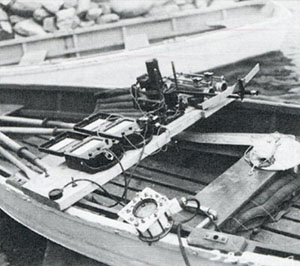
| University of Washington’s Weston submarine photometer (light meter). Photo courtesy of the National Park Service |
Their purpose was to determine whether the fallout of tritium, strontium-90, and other radioisotopes associated with nuclear weapons testing was greater over oceans than over land. Volchok and other investigators considered Crater Lake an ideal study site. The lake’s surface area comprises nearly 80 percent of the entire drainage basin, and only about 0.5 percent of the lake’s total volume is lost to seepage each year. They also believed that the lake mixed entirely each year, which meant that the tritium content could be estimated during any season. The total strontium-90 in lake water and sediments was estimated at 4.2 curies, roughly equivalent to the amount of strontium-90 reported for land areas around the lake and elsewhere in Oregon. (33) In August 1966 and again in July 1969, Raymond Smith and John Tyler of Scripps measured the distribution of natural light to a depth of 330 feet using an instrument called the Scripps spectroradiometer, which Tyler had originally tested at Crater Lake in 1965. Their optical measurements confirmed earlier reports about the lake’s exceptional water clarity and provided precise baseline data, which gave future scientists information so they could determine how and to what extent the lake’s optical properties might have changed. (34)
In February 1971, Victor Neal, Stephen Neshyba, and Warren Denner-oceanographers from OSU-became the first scientists to conduct research on the lake during winter. Theirs was a difficult and hazardous task. They had to negotiate a single, precipitous
trail that switchbacked for over a mile down the steep caldera wall while facing storms with high winds and poor visibility The snow was as much as fifty feet deep, and there was a constant threat of avalanches. The team had visited the lake over the previous two years to make precise measurements of the lake’s seasonal temperature gradients. (35) This initial winter data provided a better understanding of the lake’s yearly temperature characteristics and effects, particularly about why the lake rarely froze over and whether lake temperatures were uniformly low at all depths throughout the winter. By June 1971, however, this work and Donaldson’s limnological program came to an end, apparently due to a lack of adequate funding.
After 1971, limnological research at Crater Lake was discontinued for seven years, probably because the Park Service was either unwilling or unable to provide any funding. In June 1978, I returned to the lake to conduct an independent research program. The National Park Service loaned me a two-person rubber dinghy and a park employee to operate the boat’s three-horsepower outboard motor. We lowered water-sampling gear and various instruments into the lake with a homemade wooden winch and cable reel containing 2,000 feet of rope, which had been built for me by my father, Gunnard Larson. I used the dinghy and winch system for four summers, from 1978 through 1981, sometimes during storms that whipped up waves large enough to nearly swamp the tiny boat as we crossed the lake. In 1982, after someone in the Park Service finally realized that a rubber dinghy crammed with two people and limnological equipment was unsafe on Crater Lake, I received a twenty-four-foot aluminum pontoon vessel that was powered by a thirty-five-horsepower outboard motor. This boat, faster and more durable, was the first one ever purchased by the Park Service for research on Crater Lake.
| Deep-sea Nansen-type water bottle. Photo courtesy of the National Park Service |
I returned to Crater Lake to learn more about the abundance, vertical distribution, and species composition of phytoplankton, all of which were poorly understood at the time. I also wanted to continue the research that I had begun with Donaldson, Malick, and Hoffman ten years earlier. Between 1978 and 1983, approximately nine hundred water samples were collected for phytoplankton analysis. Stan Geiger, a Portland algae expert, examined the samples and identified more than one hundred species of phytoplankton, roughly 75 percent of which were diatoms. Three species were dominant-two diatoms (Nitzschia gracilis, Stephanodiscus hantzschii) and yellow-green algae (Tribonema affine). Living phytoplankton were found at depths extending to nearly one thousand feet, although 95 percent of the phytoplankton was concentrated in the lake’s upper five hundred feet. During summer, Nitzschia gracilis became increasingly abundant in the lake’s surface waters, usually reaching maximum numbers by late August. The vertical distribution of phytoplankton in Crater Lake is analogous to a tropical rain forest in which communities of organisms aggregate into vertically distinct, environmentally disparate zones down through the forest canopy In Crater Lake, the three predominant species of phytoplankton are distributed in distinct depth zones. This three-tier structure, in which the phytoplankton live at different depths, is not common among lakes. In most lakes, especially shallow ones, the phytoplankton are more or less distributed homogeneously. (36)
Other independent researchers also studied Crater Lake from 1978 through 1983. In August and September 1979, Stanford Loeb and John Reuter of the University of California at Davis obtained information on benthic plants inhabiting the lake’s shallow, near-shore waters. A year or so later, David Williams of the USGS and Richard Von Herzen of Woods Hole studied heat flow into the lake and discovered two thermal spring areas on the deep lake floor. They concluded that warm water from the springs ascended through the lake, mixing it from bottom to surface. As the water is heated, it becomes less dense, or lighter. Because the spring waters are warmer than lake waters, they circulate upward (convection), causing the lake to be vertically mixed. (37)
Crater Lake has long been celebrated for its intensely blue color and extraordinary water clarity. On August 27, 1937, Arthur Hasler lowered an eight-inch-diameter white Secchi disk into the lake and observed that it disappeared at a depth of 131 feet; earlier, on August 10 and 19, he had recorded Secchi depths of 118 and 128 feet. These measurements established an important reference point for future scientists who would study the lake’s unusual optical properties. G. E. Hutchinson, renowned limnologist at Yale University, described the lake in 1957 as “almost optically pure.” l re-measured the lake’s water clarity in 1969, obtaining a Secchi depth of 144 feet on July 16. At the time, this depth was thought to be a record Secchi measurement for lakes of the world. (38)
When I took optical measurements almost ten years later in the summer of 1978, however, all of the Secchi-depth readings were less than one hundred feet. The lake’s water clarity had decreased by roughly 25 to 30 percent. This decline in clarity continued through the 1980s. In August 1991, all Secchi readings for the month were less than 85 feet. Once, on August 26, 1991, the disk was visible to a depth of only 67 feet, or about half the distance measured in 1969. Needless to say, these readings were disturbing. Scientists had expected the lake’s rare optical properties to last for “ages” because of its “relative inaccessibility, unique morphometry (bathymetry) and protection by the National Park Service.” (39)
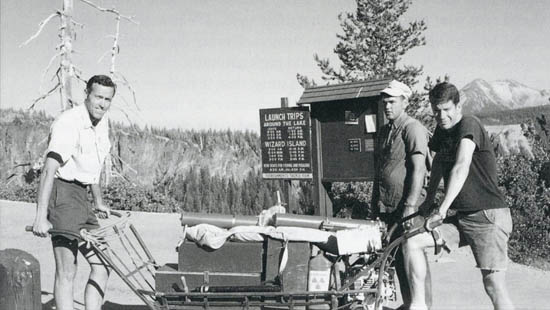 |
| In July 1968, John Donaldson, James Malick, and Owen Hoffman prepare to go down the Cleetwood trail with their limnological equipment loaded on a motorized trail packer. Photo by D. W. Larson |
When reports about the lake’s possible optical deterioration finally reached the public, concerns were raised that the tourists who crowded the park each summer were the culprits. Between 1902 and 1940, fewer than 3 million people had visited Crater Lake National Park. Following World War 11, however, the park’s summertime visitation rate rose dramatically, and close to six hundred thousand people visited the park each summer throughout the 1970s. Between 1970 and 1982, the Park Service counted 8 million visitors to the park. (40)
Although there was no firm explanation for the decrease in the lake’s clarity, some scientists believed that it was related to an unusual abundance of phytoplankton inhabiting the lake’s waters to a depth of about one hundred and fifty feet. Researchers who had studied the lake speculated that the phytoplankton had become more abundant because of an unnatural increase in concentrations of essential plant nutrients, especially nitrogen. We had found that nitrogen concentrations in Crater Lake were extremely small and that additions of nitrogen from anthropogenic sources, such as sewage, could greatly stimulate the growth of phytoplankton and other lake algae. The source of this nutrient enrichment, researchers suspected, was the park’s sewage disposal facilities on the caldera rim, specifically the septic tank-drainfield system that processed an estimated 16 million gallons of raw sewage every summer. This system had been designed in the mid-1940s to accommodate about two hundred thousand visitors each summer. It was improved in 1975 shortly after the park’s main source of drinking water, a springfed creek, had become grossly contaminated with sewage, causing more than a thousand cases of diarrhea and other waterborne ailments among park tourists and staff. (41)
The news media picked up the story about Crater Lake’s diminishing water clarity in 1981. On December 20, 1981, the Oregonian reported that scientists suspected that sewage was the cause and that they were frustrated by the scarcity of historical lake data, which was needed to determine if the loss of clarity was a new condition or a recurrent one. The Oregonian quoted James Rouse, superintendent of Crater Lake National Park, who said that “the only sewage that could get into the lake would have to come from either two outhouses on the lake’s Wizard Island, or from two sewage lagoons which are about 200 feet higher than, but two miles removed from the lake.” (42) Oddly, Superintendent Rouse failed to mention the park’s main sewage facility on the rim, located only a few hundred feet from the lake and consisting of a septic tank and drainfield that handled millions of gallons of raw sewage each summer. Shortly after, Congressman Denny Smith, a Republican from Salem, sponsored an amendment to a bill in Congress directing the National Park Service to study the clarity problem at Crater Lake and “to immediately implement such actions as may be necessary to assure retention of the lake’s pristine water quality” Smith’s amendment became Public Law 97-250 in September 1982, authorizing a boundary modification of Crater Lake National Park and a ten year monitoring program to investigate possible lake pollution. (43)
| An example of a diatom found in Crater Lake, Stephanodiscus hantzschii, with a diameter of roughly five micrometers or 0.0002 inches, photographed by a scanning electron microscope. Photo courtesy of Stan Geiger, Portland, Oregon |
The Park Service proceeded to study the lake, as directed, but the agency continued to stall on the issue of sewage contamination. Meanwhile, during the summer of 1983, scientists made another unsettling discovery. Chemical analyses of spring waters emerging along the caldera wall and flowing into the lake indicated that one of the springs contained roughly ten times more nitrogen than any of the other forty to fifty caldera springs tested. Using maps and sketchy geological information, the scientists determined that this nitrogen-enriched spring, called Spring 42, was part of a groundwater aquifer flowing directly beneath the septic tank-drainfield system. The scientists surmised that septic wastewater was percolating through drainfield soils into the aquifer. (44) This information was passed on to J. F. Quinlan, an outspoken Park Service geologist, who strongly recommended that a dye-injection study be conducted immediately to trace the pathway of wastewater seepage through underlying soils and rock. Unfortunately, this work was never attempted, and the question of sewage contamination was never resolved.
Since 1984, as part of the ten-year lake-monitoring program, the Park Service has funded several limnological investigations of the lake, including (1) additional research on phytoplankton by David McIntire of OSU; (2) a zooplankton study by Elena Karnaugh of OSU, who discovered nine rotifer species; and (3) precise chemical and isotopic analyses of Crater Lake water by J. M. Thompson and Manual Nathenson of the USGS. (45) Oceanographers Robert Collier and Jack Dymond of OSU have conducted extensive research on the lake’s mixing processes, temperature and oxygen gradients, water and sediment chemistry, and the recycling of nutrients from phytoplankton and other organic matter that settles through the water column. In 1988 and 1989, the two researchers explored the lake’s great depth with a one-person submarine called Deep Rover. They searched for evidence of geothermal activity on the lake bottom and found bacterial mats associated with what they believed to be thermal springs. (46) In 1993, the National Park Service provided Congress with a progress report on the first ten years of the Crater Lake monitoring and research program. The program was extended for an additional ten years at a estimated cost of $1.6 million. The second phase of the program is currently under way. Whether the Park Service intends to continue the program after the second phase, which terminates in 2002, is uncertain. Perhaps by then both the Park Service and Congress will recognize that long-term monitoring and research are essential for the protection of Crater Lake, and they will continue to support successive ten-year studies. Recently, the North American Lake Management Society (NALMS) published a monograph on the limnology of Crater Lake, which included papers on the limnological program mandated by Congress in 1982, the lake’s physical and chemical attributes, and the lake’s biology. (47)
And the sewage problem? In 1991, thirteen years after first being alerted to the possibility of sewage contamination in Crater Lake, the Park Service quietly removed its lake-polluting septic tanks from the caldera rim and diverted the sewage through a new $3 million pipeline. Coincidentally, since then the lake’s remarkable water clarity has been more or less restored. In August 1994, the Secchi disk was observed to a depth of 134 feet. But whether this improvement in water clarity resulted from sewage diversion is still unknown. (48)
Crater Lake is a world-class natural wonder, a national treasure, and Oregon’s crown jewel of the Cascades. The pollution of this unique body of water with unknown quantities of untreated sewage was clearly not the legacy that Americans had in mind nearly a century ago when the lake became a national park. In July 1967, when I first descended into the caldera to study Crater Lake, I did so believing that the lake was in good hands with the National Park Service. Like most Americans, I had grown up with the notion that national parks were being protected and preserved at all costs. After all, it is the stated objective of the National Park Service to “conserve the scenery and the natural and historic objects and the wild life therein and to provide for the enjoyment of the same in such manner and by such means as will leave them unimpaired for the enjoyment of future generations” [emphasis added]. (49)
Twenty years later, when I made my final ascent up the caldera wall after my last day of research on Crater Lake, my views had changed. As I reflect on my long experience there, I am constantly struck by two perplexing questions: Why did the Park Service wait eighty years before initiating a lake-monitoring program that could alert officials to possible degradation resulting from human encroachment? And why did the Park Service delay action for nearly fifteen years before correcting the sewage problem, all the while either ignoring it or denying that it existed?
| In July 1978, ranger-naturalist Seth Phalen operates a three-horsepower outboard motor on the boat the author used between 1978 and 1981 to study Crater Lake. A small plankton net hangs from the wooden winch in the center of the boat. Photo courtesy of D. W. Larson |
One can only speculate about the Park Service’s motives and reasoning. Park Service officials may have been complacent about the lake’s vulnerability to human encroachment, particularly during the park’s first forty-five years of existence when only about seventy-five thousand people visited the lake each year. Perhaps no one could imagine that people touring the caldera rim five hundred to a thousand feet above the lake posed a serious threat to lake quality Perhaps, too, the Park Service believed that the lake was large enough to assimilate various pollutants without harmful effects, thus precluding the need for monitoring. This complacency is evident in the Park Service’s decision during the 1940s to locate the park’s septic tank-drainfield system directly on the caldera rim, about seven hundred feet above the surface of the lake in soils that the USGS describes as “so highly permeable that in places all precipitation infiltrates where it falls.” (50)
There were other factors that can also explain why scientific research at Crater Lake was limited. The field of limnology was a relatively small and highly specialized discipline during the first half of the twentieth century, with limnological research confined largely to eastern and Midwestern states, particularly New York, Wisconsin, and Minnesota.
Even there, few lakes were studied. W. T. Edmondson reported in 1966 that little was known about the limnology of natural lakes in the Pacific Northwest and California. In fact, only a handful of lakes had ever been studied, including Lake Washington in Seattle, alkaline lakes in Washington’s Lower Grand Coulee, Upper Klamath Lake in Oregon, and Crater Lake. (51) During the 1960s, however, the number of limnologists, oceanographers, and other aquatic specialists increased considerably as the United States invested heavily in scientific research and training to compete with the Soviet Union. This, coupled with passage of the National Environmental Policy Act of 1969 and the Clean Water Act of 1972, resulted in a plethora of lake studies nationwide. In the Pacific Northwest, limnologists and other scientists began to take interest in the unique qualities of Crater Lake.
The lake’s near inaccessibility and great depth also hindered research. The lake was reached by a single, tortuous trail that switchbacked down the steep caldera wall for roughly one mile. Sensitive limnological equipment and other gear had to be transported up and down the trail on a motorized trail packer, which was not always available. Weather conditions were occasionally unfavorable and even dangerous. Winter research was not even attempted until 1971, when oceanographers from Oregon State University risked avalanches and hypothermia to collect wintertime limnological data. Expensive oceanographic equipment was often needed to probe the lake’s depths and collect samples. These conditions, in addition to the fact that the Park Service did not provide funding for lake research until 1983, discouraged many scientists from studying the lake.
It is puzzling why Park Service officials responded as they did to the sewage issue. Perhaps they realized they had a serious pollution problem on their hands but wanted to avoid adverse publicity and career-ending allegations of mismanagement and neglect. They had already been embarrassed by the discovery in 1975 that sewage had contaminated the park’s main source of drinking water. In October 1978, when I first alerted Park Service officials to possible sewage contamination of the lake, I was initially met with nervous skepticism and, later, with resentment for even suggesting such a possibility. I had expected, perhaps naively, that my heads-up information would be well received and that the Park Service would take remedial action before the lake was irreversibly damaged. Instead, the sewage contamination of Crater Lake continued unabated, the impact of which was never scientifically determined.
Crater Lake is a fragile environment besieged by over a half-million visitors each summer and pressured from all sides by relentless cultural expansion, including logging operations, ski resorts, highways, real estate development, and “improvements” to tourist facilities inside the park. Increasing amounts of air pollutants, derived principally from motor vehicles and industries, continue to enter the lake through precipitation and overland runoff. And unless the lake is routinely monitored and researched, we cannot know whether or not it is being damaged until it is too late to take corrective action. In 1886, Clarence Dutton marveled at visitors’ responses to Crater Lake: “It was touching to see the worthy but untutored people, who had ridden a hundred miles in freight-wagons to behold it, vainly striving to keep back tears as they poured forth their exclamations of wonder and joy akin to pain.” (52) Visitors are still moved by the incredible beauty of Crater Lake. If we do not pay attention, however, that beauty may again be diminished, next time possibly forever.
| The author poses on his first field trip to Crater Lake in July 1967. Photo courtesy of D. W. Larson |
Notes
The author extends thanks to Dr. James LaBounty, U.S. Bureau of Reclamation, Denver, for his editorial assistance and encouragement and to Stan Geiger, Shapiro and Associates, Portland, who spent hundreds of hours pro bono correctly identifying and photographing the phytoplankton in Crater Lake.
- C. E. Dutton, “Crater Lake, Oregon,” Science 7:160 (1886): 179.
- W G. Steel, quoted in Ron Warfield et al., Crater Lake: The Story behind the Scenery (Las Vegas, Nev.: KC Publications, 1982), 41.
- Dutton, “Crater Lake,” 179.
- For example, see Warfield et al., Crater Lake, 44.
- “Act of May 22, 1902, Reserving a Certain Tract of Land from Public Lands in Oregon as a Public Park,” U.S.C., title 16, sect. 121, 122, 123.
- D. W Larson, “Crater Lake Limnological Studies, 1983,” Annual Report on the Limnology and Water Quality Monitoring Program at Crater Lake National Park, Oregon (Seattle: National Park Service, Pacific Northwest Region, 1984); Register-Guard (Eugene, Oregon), September 27, 1987; D. W. Larson et al., “Limnological Response of Crater Lake to Possible Long-Term Sewage Influx,” in Crater Lake: An Ecosystem Study, ed. E. T. Drake et al. (San Francisco: Pacific Division, American Association for the Advancement of Science, 1990), 197-212; U.S. Department of the Interior, Crater Lake National Park, Mazama Campground of Rim Village Corridor, Oregon (Seattle: National Park Service, Pacific Northwest Region. 1987).
- W T. Edmondson, The Uses of Ecology (Seattle: University of Washington Press, 1991), 286.
- Robert M. Linn, ed., Proceedings of the First Conference on Scientific Research in the National Parks, vol. 1 (Washington, D.C.: GPO, 1976), xxii-xxiii.
- K. R. Cranson, Crater Lake, Gem of the Cascades (Lansing, Mich.: KRC Press, 1982); J. V. Byrne, “Morphometry of Crater Lake, Oregon,” Limnology and Oceanography 10:3 (1965): 462-5.
- K. N. Phillips and A. S. Van Denburgh, “Hydrology of Crater, East and Davis Lakes, Oregon,” U.S. Geological Survey Water-Supply Paper, No. 1859-E, 1968; K. T. Redmond, “Crater Lake Climate and Lake Level Variability,” in Crater Lake, ed. Drake et al., 127-41; B. F. Walker, “The Frozen Lake,” Crater Lake Nature Notes 15 (1949): 8; R. J. Collier et al., “Chemical and Physical Properties of the Water Column at Crater Lake, Oregon,” in Crater Lake, ed. Drake et al., 69-79.
- J. S. Diller, “Crater Lake, Oregon,” National Geographic 7 (February 1897): 33-46; Dutton, “Crater Lake.”
- J. S. Diller and H. B. Patton, “The Geology and Petrography of Crater Lake National Park,” U.S. Geological Survey Professional Paper. No. 3, 1902; Redmond, “Crater Lake Climate.”
- Diller and Patton, “The Geology and Petrography of Crater Lake,” 52.
- W. Van Winkle, “Quality of the Surface Waters of Oregon,” U.S. Geological Survey Water-Supply Paper, No. 363, 1914, 43. They tested for silica, iron, magnesium, calcium, sodium, potassium, chloride, nitrate, phosphate, sulfate, bicarbonate, carbonate, and total dissolved solids.
- G. Kemmerer et al., “Northwestern Lakes of the United States,” Bulletin of the Bureau of Fisheries 39 (1924): 51-140.
- Diller, “Crater Lake,” 379.
- J. S. Brode, “The Waters of Crater Lake,” Crater Lake Nature Notes 7:3 (1934): 4-5; idem. “Food Habits of Crater Lake Fish,” Crater Lake Nature Notes 8:2 (1935) 11-13; idem, “The Denizens of Crater Lake.” Northwest Science 12:3 (1938): 50-7.
- A. D. Hasler, “Fish Biology and Limnology of Crater Lake. Oregon,” Journal of Wildlife Management 2:3 (1938): 95; A. D. Haslerand D. S. Famer, “Fisheries Investigations in Crater Lake. Oregon, 1937-1940,” Journal of Wildlife Management 6:4 (1942): 319-27.
- Kemmerer et al., “Northwestern Lakes”; 0. L. Wallis and C. E. Bond. “Establishment of Kokanee in Crater Lake, Oregon,” Journal of Wildlife Management 14:2 (1950): 190-3.
- Hasler, “Fish Biology,” and Hasler and Farner, “Fisheries Investigations,” 324.
- Wallis and Bond, “Establishment of Kokanee”; M. W Buktenica and G. L. Larson. “Ecology of Kokanee Salmon and Rainbow Trout in Crater Lake,” in Crater Lake, ed. Drake et al., 185-95.
- C. L. Utterback et al., “Some Planktonic and Optical Characteristics of Crater Lake, Ecology 23:1 (1942): 102.
- Ibid.
- H. E. Sovereign, “The Diatoms of Crater Lake, Oregon,” Transactions of the American Microscopy Society 77:1 (1958): 96-134; idem. “New and Rare Diatoms from Oregon and Washington,” Proceedings of the California Academy of Sciences 31:14 (1963):349-68.
- C. W. Fairbanks and J. R. Rowley. “Lake Research, 1954.” File Report, Crater Lake National Park, National Park Service, 1954; idem, “Tribute to the Clarity of Crater Lake,” Crater Lake Nature Notes 20 (1954): 34-6; J. R. Rowley and C. W. Fairbanks, “Aquatic Flowering Plants of Crater Lake,” Crater Lake Nature Notes 20 (1954): 36-9.
- J. R. Rowley and J. S. Rowley, “The Discovery of Myriophyllum in Crater Lake,” Crater Lake Nature Notes 22 (1956): 3-4; K. Thomasson, “Planktological Notes from Western North America,” Arkivfor Botanik 4:14 (1956): 437-63.
- Howel Williams. “The Floor of Crater Lake, Oregon.” American Journal of Science 259 (1961):81-3.
- Byrne. “Morphometry of Crater Lake.”
- C. H. Nelson, “Geological Limnology of Crater Lake, Oregon” (M.S. thesis, University of Minnesota, Minneapolis, 1961); idem, “Sediments of Crater Lake, Oregon,” Geological Society of America Bulletin 78 (1967): 833-48.
- Phillips and Van Denburgh, “Hydrology of Crater, East and Davis Lakes”; E. B. Thornton, “Investigations at Crater Lake. Hydrologic Benchmark,” Water Resources Division Bulletin, USGS (January 1965), 23-6; U.S. Geological Survey, “Water Resources Data, Oregon, Water Year 1996,” Water Data Report OR-96-1, 1997).
- W. E. Kartchner and J. E. Doerr. “Wind Currents in Crater Lake as Revealed by the Old Man of the Lake.” Crater Lake Nature Notes 11:2 (1938): 31-5; H. V Kibby et al., “Temperature and Current Observations in Crater Lake, Oregon,” Limnology and Oceanography 13:2 (1968): 363-6.
- F. O. Hoffman, “The Horizontal Distribution and Vertical Migrations of the Limnetic Zooplankton in Crater Lake. Oregon” (M.S. thesis. Oregon State University, Corvallis. 1969); J. G. Malick, “Population Dynamics of Selected Zooplankton in Three Oligotropic Oregon Lakes” (M.S. thesis, Oregon State University, Corvallis, 1971); D. W. Larson, “Temperature, Transparency, and Phytoplankton Productivity in Crater Lake, Oregon.” Limnology and Oceanography 17:3 (1972): 410-17.
- H. L. Volchok. “Strontium-90 Fallout in Crater Lake,” Technical Memorandum. No. 67- 16, U.S. Atomic Energy Commission HASL Report, 1967; H. L. Volchok, et al., “Ocean Fallout: The Crater Lake Experiment.” Journal of Geophysical Research 75:6 (1970): 1084-91; H. J. Simpson, “Tritium in Crater Lake. Oregon,” Journal of Geophysical Research 75:27 (1970): 5195-207; J. S. Leventhal and W. F. Libby, “Tritium Fallout in the Pacific United States,” Journal of Geophysical Research 75:35 (1970): 7628-33.
- R. C. Smith and J. E. Tyler, “Optical Properties of Clear Natural Water,” Journal of the Optical Society of America 57:5 (1967): 589-95; R. C. Smith et al., “Optical Properties and Color of Lake Tahoe and Crater Lake,” Limnology and Oceanography 18:2 (1973): 189-99.
- V. T. Neal et al., “Temperature Microstructure in Crater Lake, Oregon.” Limnology and Oceanography 16:4 (1971): 695-700; idem, “Vertical Temperature Structure in Crater Lake. Oregon,” Limnology and Oceanography 17:3 (1972): 451-3.
- N. S. Geiger and D. W Larson, “Phytoplankton Species Distribution in Crater Lake, Oregon, 1978-1980.” in Crater Lake, ed. Drake et al., 153-65; D. W. Larson et al., “Vertical Partitioning of the Phytoplankton Assemblage in Ultraoligotrophic Crater Lake, Oregon,” Freshwater Biology 18 (1987): 429-42.
- S. L. Loeb and J. E. Reuter, “The Epilithic Periphyton Community,” Verhandlungen Internationale Vereinigungfur Theoretische und Angwandte Limnologie 21 (1981): 346-52; D. L. Williams and R. F1 Von Herzen, “On the Terrestrial Heat Flow and Physical Limnology of Crater Lake, Oregon,” Journal of Geophysical Research 88:B2 (1983): 1094-104.
- E. Pettit, “On the Color of Crater Lake Water,” Proceedings of the National Academy of Science 22:2 (1936): 139-46; G. E. Hutchinson, A Treatise on Limnology, Vol. I: Geology, Physics, and Chemistry (New York: John Wiley, 1957), 409; Hasler, “Fish Biology and Limnology of Crater Lake”; Lake survey files, Oregon Department of Fish and Wildlife, Springfield, Ore.; Larson, “Temperature, Transparency, and Phytoplankton Productivity in Crater Lake.” Since the author’s measurement in 1969, an even deeper Secchi reading of 157 feet was reported in Oregon’s ultra-pure Waldo Lake in the Cascade Range. See Lake Survey Files, Oregon Department of Fish and Wildlife, Springfield.
- D. W. Larson, “Limnology of Crater Lake, With Emphasis on Diel Vertical Distributions of Algae” (Annual Report. Natural Sciences Research, National Park Service, Pacific Northwest Region, Seattle, Wash., 1978); idem, “The Crater Lake Study,” Verhandlungen Internationale Vereinigungfur Theoretische und Angwandte Limnologie 22 (1984): 513-17; National Park Service, unpublished limnological data collected for Crater Lake, 1984-1991 (National Park Service, Pacific Northwest Region, Seattle); Smith et al., “Optical Properties and Color of Lake Tahoe and Crater Lake,” 189.
- Larson, “Crater Lake Limnological Studies.”
- G. F. Craun. “Outbreaks of Waterborne Disease of the united states: 1971-1978,” Journal of the American Water Works Association 73 (1981): 360-9.
- Quoted in Oregonian (Portland), December 20, 1981. See also, for example, Oregon Journal, December 10, 11.14.1981; Mail Tribune (Medford, Oregon), December 11, 1981; Register-Guard (Eugene. Oregon). December 12,1981; Oregonian, December 20, 1981, May 29, 1992; Herald and News (Klamath Falls, Oregon), July 25, 1982; Gazette-Times (Corvallis, Oregon), October 25, 1982; New York Times, October 25, 1982; Los Angeles Times, October 26, 1982; Seattle Times, October 27, 1982.
- U.S. House, “An Act to Correct the Boundary of Crater Lake National Park in the State of Oregon and Other Purposes,” Union Calendar Number 231, 1981; U.S. House, “Correcting the Boundary of Crater Lake National Park in the State of Oregon, and Other Purposes,” Report No. 97-383, 1981.
- Larson, “Crater Lake Limnological Studies.”
- M. K. Debacon and C. D. Mclntire, “Taxonomic Structure of Phytoplankton Assemblages in Crater Lake, Oregon, U.S.A.,” Freshwater Biology 25 (1991): 95-104; E. N. Kamaugh, “Sampling Strategy and a Preliminary Description of the Pelagic Zooplankton Community in Crater Lake,” in Crater Lake, ed. Drake et al., 177-83; J. M. Thompson et al., “Chemical and Isotopic Compositions of Waters from Crater Lake, Oregon, and Nearby Vicinity,” in Crater Lake. ed. Drake et al., 91-102.
- J. McManus et al., “Mixing Processes in Crater Lake, Oregon,” Journal of Geophysical Research 98:C10 (1993): 18,295-307; R. W Collier et al. “Chemical and Physical Properties of the Water Column at Crater Lake, Oregon,” in Crater Lake, ed. Drake et al., 69-79; J. Dymond and R. W Collier, “The Chemistry of Crater Lake Sediments,” in Crater Lake, ed. Drake et al., 41-60; M. Milstein, “Discoveries in the Deep,” National Parks (March/April 1990), 29-33; R. W. Collier and J. Dymond, “Observations of Bacterial Mats Associated with Thermal Springs at 450 Meters Depth in Crater Lake, Oregon,” Eos 69:44 (1988): 1138.
- G. L. Larson et al., “Crater Lake Limnological Studies, Final Report, Technical Report NPS/PNROSU/NRTR-93/03 (Seattle: National Park Service, 1993); Oregonian, July 28, 1993. Also see articles in Lake and Reservoir Management 12:2 (1996): 221-310.
- R. E. Shotwell, “Crater Lake Lodge Renovation Project Set,” Oregonian, April 25,1991; National Park Service, unpublished limnological data, 1984-1991.
- Quoted in “Our National Parks,” Lqe 14:6 (1991): 29.
- Phillips and Van Denburgh, “Hydrology of Crater, East and Davis Lakes,” E9.
- W T. Edmondson, “Pacific Coast and the Great Basin,” in Limnology in North America, ed. D. G. Frey (Madison: University of Wisconsin Press, 1966), 371-92.
- Dutton. “Crater Lake. Oregon,” 179.
Crater Lake Institute Note: A big thank you to the author, Douglas Larson, for allowing the Crater Lake Institute (CLI) to post this article.
